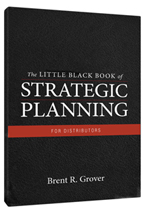Why Top-Down Budgeting Doesn’t Work
By Brent Grover
 Typical distributor annual planning is troubling for several reasons. Consider the following dreary but realistic annual planning scenario for a hypothetical distributor:
Typical distributor annual planning is troubling for several reasons. Consider the following dreary but realistic annual planning scenario for a hypothetical distributor:
The sales forecast comes from the field and is wildly optimistic. Sales managers cajole their sales reps into projecting sales increases that can only be described as best-case. In turn the regional managers badger the sales managers to inflate the revenue numbers further due to bulldozing from senior executives and the CEO. A notable exception to the optimism rule is the possibility that the sales organization has financial incentives based on exceeding the forecast, in which case the numbers are “sandbagged.” This situation only increases the arm-twisting from upper management who suspects the foul play.
The expense budget arises from the functional managers and is greatly exaggerated. The managers seek to avoid being beaten up during the year for not meeting budget. They also desire authorization to add staff in their departments and to budget good raises for people, both of which make managing easier and tend to increase compensation for the manager doing the budgeting. The CFO goes through the line items with a fine-tooth comb and haggles with the managers, anticipating bludgeoning from senior executives and the CEO.
The reality of these unpleasant activities is a net income projection that is a synthesis of inefficient and unreliable methods. The projected net income and capital expenditures plan are used for critical cash flow forecasting. Mistakes result in inadequate borrowing capacity (i.e., running out of cash) and the potential breach of lending covenants.
I advocate a bottom-up annual planning process that starts with the most important objective on the one-page strategic plan: return on investment (ROI). How much return is needed to attract capital (equity and borrowed funds) to the business? The demands of the owners and lenders, including suppliers, must be met if the company is to have a future. Net income for next year is simply revenue minus cost of goods sold (gross margin dollars) less expenses.
Here’s what you should consider when doing the math:
Revenue
Revenue expectations must be tempered against three marketplace realities:
What economic growth is expected?
The economic growth question is not purely macroeconomic, in the sense of the entire economy or even regional economic expansion or contraction. The specific concern is the micro-economy, the customer segments in the region and particularly major customers. Have customers announced hiring or layoffs, plant openings or closings? How will expected acquisitions or divestitures help or hurt volume?
What price changes are anticipated?
Similarly, the subject of price changes is not in the context of the overall economy. The concern is with what is known or expected about major suppliers’ pricing intentions and an informed opinion about when the changes will occur and the likelihood of acceptance in the market.
What share of competitors’ business are we positioned to capture?
Finally, management must grapple with the challenge of gaining market share both by capturing customers from competitors, as well as increasing penetration at established accounts. Data from the field about targeted business and contracts already gained and lost is useful. Naturally competitors are planning to attack and include business they want in their plans for the coming year. Who will win more of those battles? Which companies are best positioned to grab a bigger slice of the overall market and more of the best customers’ wallets? Management must confront the reality of how well their company is positioned in each geographic market, for each customer segment and with its products and services. Does the company have enough talented salespeople on the street? Are they highly qualified? Does the company have the right product lines? Does the business block and tackle well (high fill rate, timely delivery, low error rate)?
Margin Expectations
Judgment must be applied to lofty margin expectations, as well. The company’s ability to increase margins depends on some of the variables mentioned in the preceding paragraph (sales talent, product lines, blocking and tackling). Pricing success relies also on the company’s pricing architecture and processes: how prices are set, how much autonomy the sales force has, availability of market pricing data, how the sales reps are managed and incentivized. We have seen too many firms automatically plug a 50- or 100-basis-point (0.5% or 1%) margin increase into the plan each year, often for no apparent reason.
Expense Budgeting
Expense budgeting is just another forecasting exercise. The quick-and-dirty approach for budgeting non-people expenses is to simply assign a percentage increase to last year’s expense amount on each line item. It is just as hasty to slash or even cross out expense lines without researching what the benefits of the expenditures are and how customers are affected. Each expense line must start over each year from zero with a buildup of dollars allotted to each expenditure based on how the investment affects customers.
People expenses are more sensitive and complex. Each functional area must list each individual and the annual cost of his ongoing employment: hourly including overtime, salaries, commissions, bonuses, fringe benefits, etc. The budget for the coming year must include a provision for compensation changes, bonuses, overtime work and changes in fringe benefit programs. The effect of timing of compensation changes is too large to overlook.
After the first pass, the bottom-up approach calls for iterations to the expense budget to produce the required net income based on the expected gross margin dollars. Subsequent versions of the expense budget force management to make difficult choices and trade-offs about people and non-people expenses.
Three Sets of Business Plans
The assumptions behind any forecast and budget are fluid. But the assumptions are critical because of the cascading effect on the resulting sales and margin forecasts and naturally on the expense budget. It would be hasty to slash expenses prematurely based on a draconian forecast that turns out to be wrong. Because of this, I suggest three sets of annual business plans: base case, worst case and best case.
 This is an excerpt from Brent Grover’s new book, The Little Black Book of Strategic Planning for Distributors, available for order at www.mdm.com/littleblackbook or by calling 888-742-5060. It is also available through amazon.com.
This is an excerpt from Brent Grover’s new book, The Little Black Book of Strategic Planning for Distributors, available for order at www.mdm.com/littleblackbook or by calling 888-742-5060. It is also available through amazon.com.
Brent R. Grover is managing partner of Evergreen Consulting LLC. He serves as an adviser to the distribution channel on strategic planning, mergers and acquisitions, and profit improvement. Brent can be reached at brent@evergreen-consulting.com.













